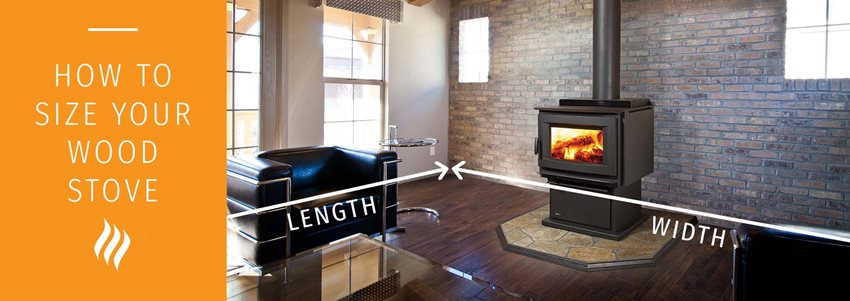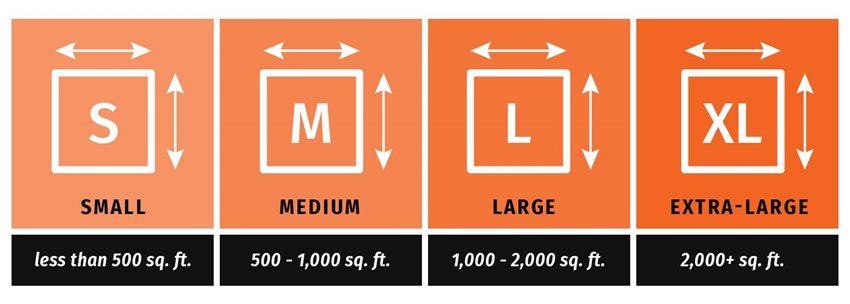
How To Find the Right Sized Wood Stove For Your Home
Typically, wood stoves are classified into four sizes – small, medium, large, and extra-large. As a basic benchmark, a small wood stove will heat less than 500 sq. ft., a medium wood stove will heat between 500 – 1,000 sq. ft, a large wood stove will heat between 1,000 – 2,200 sq. ft., and an extra-large wood stove will heat over 2,200+ sq. ft. These figures are based on an average size, single-story home in a moderate climate, and an open floor plan.
It is important to size your wood stove based on its heating capacity for a full load of wood. A full load is important to reducing creosote buildup and keeping the glass clean. Putting too large of a stove in too small a space can result in building smaller fires which can lead to dangerous or unsightly buildup of creosote.
Standard Wood Stove Square Foot Heating Capacity
- Small Wood Stove: less than 500 sq. ft.
- Medium Wood Stove: 500 - 1,000 sq. ft.
- Large Wood Stove: 1,000 - 2,200 sq. ft.
- Extra-Large Wood Stove: 2,200+ sq. ft.
Note: this is simply a benchmark. A wood stove's actual heating capacity will vary dramatically based on a high number of factors, see below for more details, and always discuss sizing and installation with an Authorized Regency dealer.
Factors Affecting Wood Stove Heating Capacity?
There is a wide variety of factors that can influence the heating capacity of your wood-burning stove, some of these include:
- Ceiling Height
- The total volume of the room can drastically change the heating capacity of a wood stove
- Insulation
- Older poorly insulated homes will decrease the heating capacity of a stove, whereas new highly insulated homes may increase the capacity of the stove
- Number of Windows
- Windows (even dual-pane) are a source of cooler air, and the more windows in a home/room, the greater the obstacle to the stoves heating capacity
- Room/Wall Layout
- Open rooms vs. homes with lots of walls will affect how effective the stove is at heating an area
- Type of Wood
Which Technology Is Right For You?
When choosing a wood stove, you don’t just need to decide between a small, medium, large, or extra-large stove; you also need to decide what type of burn technology you want. Regency offers both Non-Catalytic wood stoves and Hybrid Catalytic wood stoves. The difference between the two is the reburn systems used to reduce emissions, increase efficiency, and generate longer burn times. Both technologies produce high-efficiency fires and are all EPA-certified to the latest in clean air standards.
One technology is not inherently better than the other. Catalytic and non-catalytic wood stoves operate differently and, therefore, have different applications. Catalytic wood stoves are better suited to long, stable, continuous primary heating applications, whereas non-catalytic wood stoves are suited to intermittent or supplemental heating applications.
Explore the difference in wood-burning technologies and find the right stove technology for you!
Regency Wood Stoves by Size

Small Wood Stoves
Medium Wood Stoves
Large Wood Stoves
Extra-Large Wood Stoves
Want some help finding the right wood stove for you? Try our
Product Wizard to narrow down the best options for you!
Frequently Asked Questions
How do I calculate what size wood burner I need?
To calculate the right size wood burner, measure the room's length × width × height to get the total cubic footage. For a well-insulated home in a temperate climate, you’ll need approximately 20 BTUs (British Thermal Units) per square foot. For example, a 400 sq. ft. room would need around 8,000 BTUs. Regency’s certified dealers can help you match the correct stove size based on your climate, insulation levels, and heating goals
What is the downside of too big of a wood stove?
An oversized wood stove can create more problems than solutions. If the stove produces too much heat, you’ll likely need to open windows or build smaller fires, which means the fire won’t burn efficiently. This leads to:
- Incomplete combustion: More smoke and creosote buildup.
- Uneven heating: Overheating near the stove, cold spots farther away.
- Frequent shutdowns: You may need to let the fire die down early, wasting wood and reducing efficiency.
A properly sized stove burns cleaner, distributes heat evenly, and maximizes comfort.
You May Also Like…